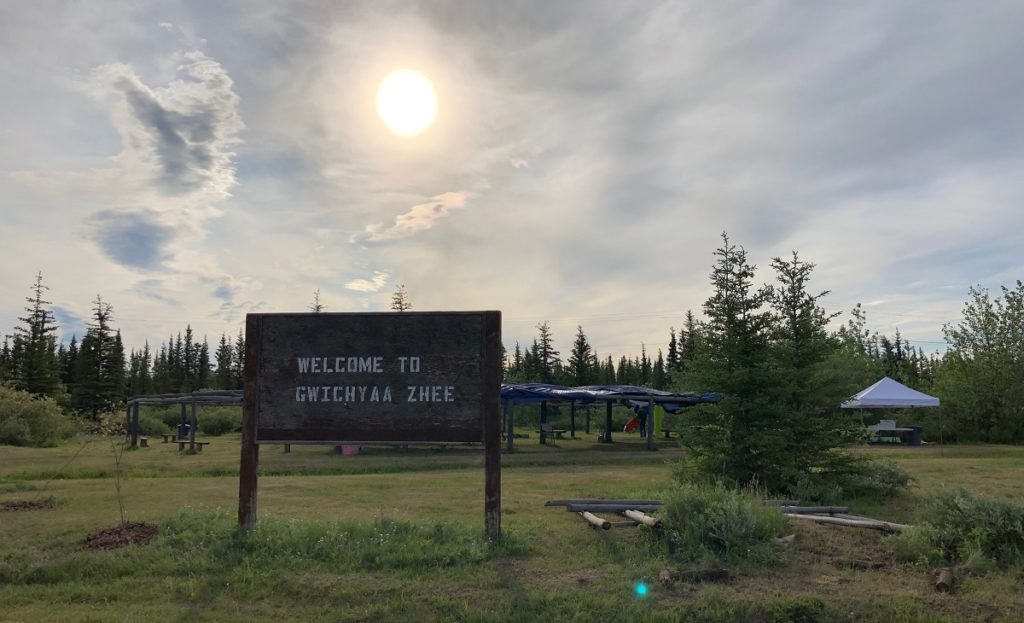Attending The Arctic Indigenous Climate Summit

This summer, Gwichyaa Zhee/Fort Yukon hosted the first ever Arctic Indigenous Climate Summit.
(Above: Welcome to Fort Yukon, Alaska — or Gwichyaa Zhee in Gwich’in. Photo: Alaska Wilderness League.)
What a powerful week — my recent trip up to Gwichyaa Zhee/Fort Yukon for the first ever Arctic Indigenous Climate Summit was my first opportunity to spend time in a small Arctic Indigenous community. The summit was hosted by our partners the Gwich’in Steering Committee, and was well run and welcoming to those of us visiting.
The event was held June 11-13, and at the end of each day, many in the greater community would join us for the evening meal, music and traditional dancing. Each evening there were also softball games (which I could hear through the trees when I was “turning in” in my tent). With basically round-the-clock light in the Arctic summer, there were no deterrents to activities lasting well into the night!

For the most part we ate shared meals in the Tribal Hall — caribou roasted or as meatloaf, some vegetables, with pasta and soups. Eggs for breakfast with bacon and sausage, fruit and always a potato side. We were well taken care of by our hosts!
“Do it in a good way, tell the world we are here, talk about our connection.” —Message from a Gwich’in Elder
The line-up of speakers was impressive — Indigenous leaders from the lower 48, as well as Gwich’in and Inupiat communities in the Arctic. The elders shared stories and observations of climate change impacts, and stories of their history and their life on the lands. The younger generations spoke up as well — the youngest village chief (at 23-years-old!) from the community of Venetie talked to us of climate change and the intersectionality of racial justice and environmental issues like education, housing and food access. These issues go hand in hand with the impact climate change is having on Fort Yukon and other Indigenous communities throughout the Arctic.
“We are rich in resources; water, land, trees — no money does not mean you are poor.” —Message from a Gwich’in hunter and traditional scientist
Food security was the subject of the summit’s first day, with climate change covered on the second. Climate and food security are naturally linked in the Arctic, and it was beautiful watching the back and forth between traditional and western scientists — sharing data, statistics, observations and ideas made for a great day loaded with science-based knowledge. We learned about the dramatic transformations happening now in the region.

In a place where food and medicine come from the land and animals, the changes happening due to our warming planet are having real-world impacts. The traditional scientists and hunters shared some of the struggles being faced in the Arctic such as shifting animal distributions, coastal erosion and the dangerous collapsing of river banks, and permafrost loss — in some places it is so far gone it cannot support the ground. Many people talked of the Porcupine caribou and the connection to culture, spirituality and life they represent.

The coastal plain of the Arctic Refuge is sacred, and this clearly came through from the people I met. It is the birth place for potentially 80,000 calves each year!

Alaska and the Arctic are ground zero for changes happening faster than the scientific models have predicted, and Arctic communities hold the key to resilience.
“Now we are at a point we can still change — we can choose to not to go down the path we know is not right in our hearts.” —Caution from an Inupiat leader
Now is the time to protect this living refuge thriving with wildlife, not destroy it in a greedy quest for oil money that will only exasperate climate impacts by continuing to feed our fossil fuel dependence. It was clear that we need to continue to come together to talk about how to change and adapt, but also to stop misguided oil development from affecting the coastal plain of the Arctic Refuge.
Our final day highlighted community organizing and elevating each other’s voices. Workshops and break-out sessions were led by Native Movement and were deeply moving.
“We are proud to hang on to what we have, hardship is not new for Indigenous people. Survival involves earth, air, sun, water. It is going to take all of our energy to say no.” —Message from an Inupiat leader
In total, the Arctic Indigenous Climate Summit was a beautiful three-day journey, but just the beginning of the process of unifying us all, connecting us in our work, and uniting us for the hard fights ahead.
